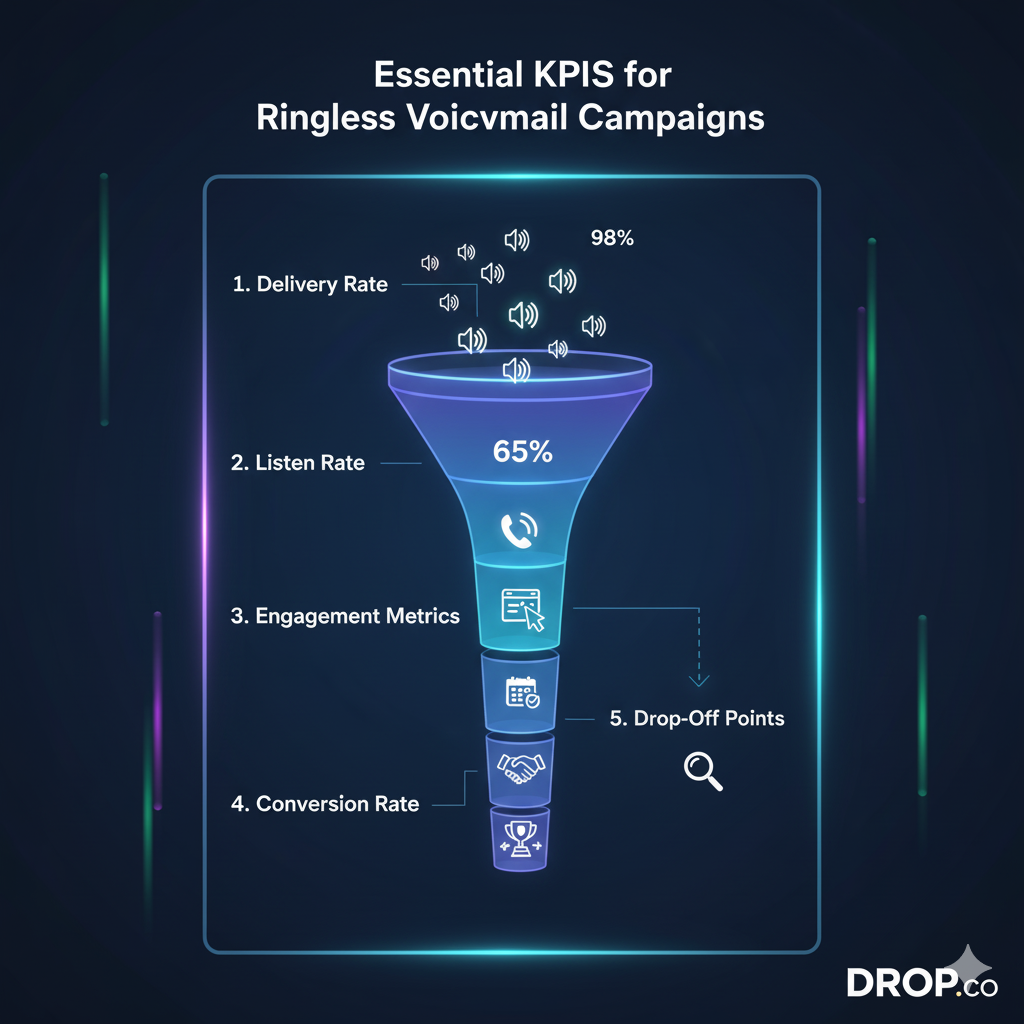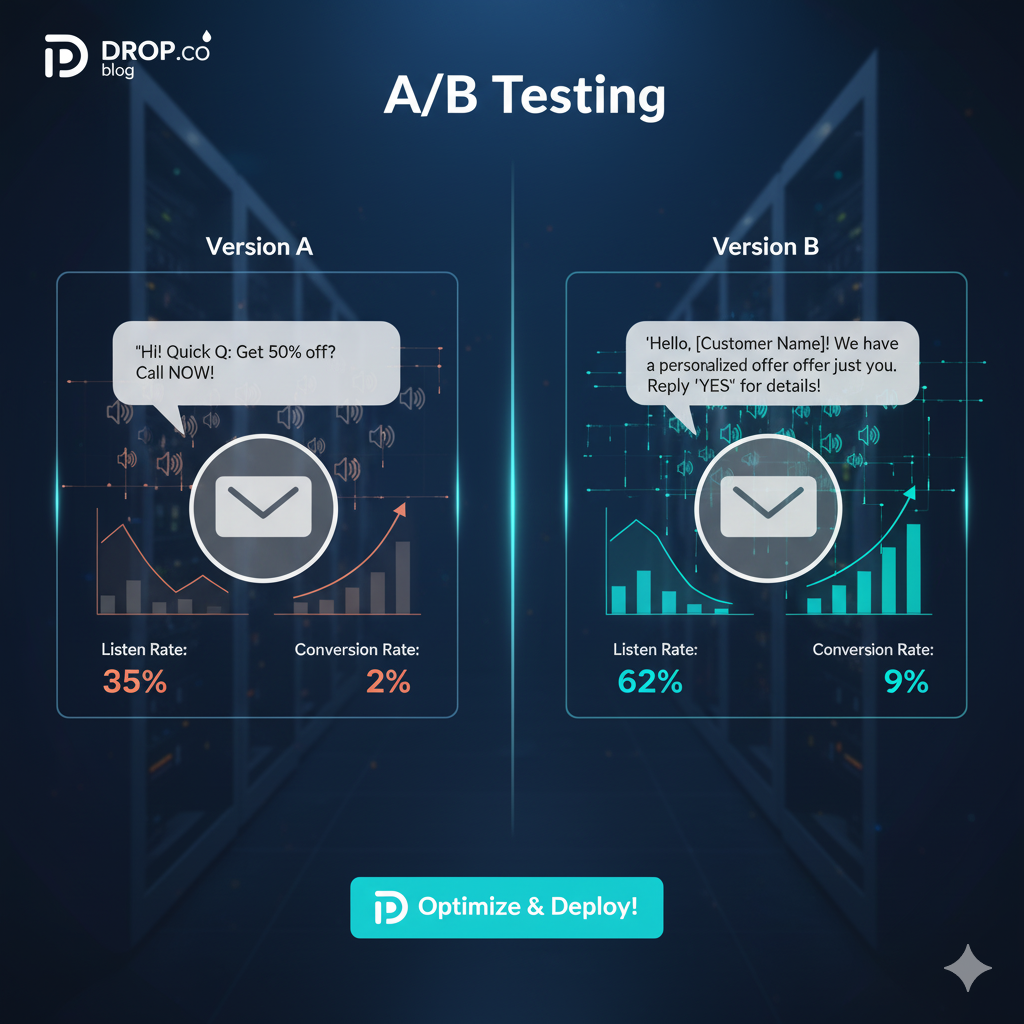Marketing success today depends on measuring and understanding performance at every step. While many businesses track metrics for email, social media, and other digital channels, ringless voicemail often goes overlooked as a source of actionable data. Yet, with the right analytics, it can provide deep insights into audience engagement, message effectiveness, and overall campaign performance.
Ringless voicemail (RVM) allows businesses to send pre-recorded messages directly to a recipient’s voicemail without disturbing them with a ringing phone. Beyond its convenience and non-intrusive nature, the platform’s real potential lies in analytics. By tracking key performance indicators (KPIs) and engagement patterns, businesses can continually refine their campaigns for higher conversion rates and better ROI.
We will explore essential KPIs for ringless voicemail, how to interpret engagement data, tips for A/B testing, and strategies for integrating voicemail analytics into your CRM or marketing dashboard.
Why Analytics Matter in Ringless Voicemail Campaigns
Marketing without analytics is like driving blindfolded. You might reach your destination eventually, but it will be inefficient and costly. Ringless voicemail analytics provide visibility into your campaign performance, helping marketers:
- Measure audience engagement with each message
- Identify which messages resonate and which don’t
- Allocate resources efficiently by focusing on high-performing campaigns
- Predict and improve conversion rates through data-informed decisions
By embracing analytics, businesses using platforms like Drop.co can move from guesswork to precise, measurable outcomes, making each campaign more effective than the last.

Essential KPIs for Ringless Voicemail Campaigns
Tracking the right KPIs is the foundation of a successful RVM campaign. Here are the most important metrics to monitor:
1. Delivery Rate
The delivery rate measures how many voicemails successfully reach the recipient’s inbox. High delivery rates indicate that your contact list is clean, and the numbers are accurate.
Why it matters: A poor delivery rate may indicate outdated phone numbers, carrier restrictions, or incorrect formatting. Monitoring this KPI ensures your messages actually reach your intended audience.
2. Listen Rate
The listen rate tells you how many recipients actually listened to your voicemail. Unlike emails, where open rates can be misleading, RVM listen rates give a clear picture of engagement.
Why it matters: Even if a voicemail is delivered, it’s ineffective if not heard. Tracking listen rates helps identify which messages grab attention and which fail to connect.
3. Engagement Metrics
Engagement goes beyond listening. It includes actions taken after hearing the message, such as:
- Returning a call
- Clicking a link (if integrated with SMS or email follow-ups)
- Visiting a landing page
- Scheduling an appointment
Why it matters: These actions reflect how compelling and persuasive your voicemail is. Higher engagement often translates directly to increased conversions and sales.
4. Conversion Rate
The conversion rate measures the percentage of recipients who take the desired action after receiving your message. This could be purchasing a product, signing up for a service, or registering for an event.
Why it matters: Conversion is the ultimate goal of any campaign. Tracking this KPI ensures your RVM efforts are translating into measurable business results.
5. Drop-Off Points
Drop-off points show where listeners stop listening or fail to complete the intended action. Understanding when and why recipients disengage can help you refine your script or call-to-action (CTA).
Why it matters: Identifying drop-off points allows marketers to improve messaging, timing, or delivery strategies, keeping more recipients engaged until the end of the voicemail.
How to Interpret Engagement Data
Analytics are only useful if you know how to interpret them. Here’s how to make sense of the numbers:
1. Compare KPIs Across Campaigns
Track performance over multiple campaigns to identify trends. For example, if listen rates are higher for 30-second voicemails compared to 60-second ones, shorter messages may be more effective for your audience.
2. Segment Your Audience
Divide your contacts into segments (e.g., by age, location, purchase history, or engagement level) and analyze KPIs for each group. Segmentation helps identify which audiences respond best and tailor messages accordingly.
3. Identify Correlations
Look for correlations between listen rates, engagement, and conversions. If a high listen rate doesn’t translate into conversions, your CTA may need adjustment. Conversely, small tweaks to messaging can significantly boost engagement if you notice a correlation.
4. Track Trends Over Time
Performance trends reveal whether your campaigns are improving, stagnating, or declining. Continuous monitoring allows you to pivot strategies quickly rather than waiting for a campaign to fail.
Tips for A/B Testing Messages
A/B testing, or split testing, is a powerful way to optimise RVM campaigns. By sending two or more variations of a message to small segments of your audience, you can see which performs better before rolling it out broadly.
1. Test Different Openers
The first few seconds of a voicemail are crucial. Experiment with different ways to grab attention, such as asking a question, offering a benefit, or introducing urgency.
2. Experiment with Length
Test short versus long messages. While concise messages are often more effective, some audiences may respond better to detailed explanations.
3. Vary CTAs
Test multiple calls-to-action to see which motivates action best. Examples include:
- “Call us back today to claim your offer”
- “Visit our website to learn more”
- “Reply via SMS to schedule an appointment”
4. Timing Tests
The time you send voicemails can affect listen and engagement rates. Experiment with mornings, afternoons, and evenings to identify optimal delivery windows.
5. Monitor Results
Use your analytics dashboard to track KPIs for each variation. Choose the message that drives the highest listen and conversion rates for your broader campaign.

Integrating Voicemail Analytics into Your CRM or Marketing Dashboard
To maximise the value of RVM analytics, integrate the data into your CRM or marketing dashboard. Doing so ensures that voicemail performance informs broader marketing and sales strategies.
1. Centralised Data
By consolidating analytics in your CRM, you can see voicemail engagement alongside email, SMS, social media, and other channels, giving you a holistic view of customer interactions.
2. Automated Follow-Ups
Trigger automated follow-ups based on voicemail engagement. For example:
- Send an email to recipients who listened but didn’t convert
- Assign a sales rep to call high-engagement leads
- Segment audiences for retargeting based on listen and engagement rates
3. Performance Reporting
Use CRM dashboards to generate real-time reports on campaign performance. Visualising KPIs helps teams quickly identify successes and areas for improvement.
4. Predictive Insights
Advanced platforms like Drop.co can leverage RVM data to predict which leads are most likely to convert, allowing your team to prioritise outreach and focus efforts where they matter most.
Best Practices for Using Ringless Voicemail Analytics
To make the most of your RVM data, consider the following best practices:
- Set Clear Goals – Define what success looks like before sending a campaign. Is it increasing conversions, boosting listen rates, or generating more appointments?
- Clean Your Contact List – Accurate phone numbers improve delivery and listen rates. Regularly update your database to reduce wasted effort.
- Monitor Continuously – Don’t wait until a campaign ends to analyse results. Track KPIs in real time and adjust messaging if needed.
- Use Segmentation Strategically – Targeted messages perform better than generic ones. Use data to tailor messages to specific audience segments.
- Learn and Iterate – Treat each campaign as a learning opportunity. Use analytics insights to continually refine scripts, delivery timing, and CTAs.
Leveraging Predictive Analytics for Smarter Campaigns
Beyond tracking standard KPIs, businesses can take ringless voicemail analytics to the next level by leveraging predictive analytics. Predictive analytics uses historical data and machine learning algorithms to forecast recipient behavior, helping you make proactive campaign decisions rather than reactive adjustments.
1. Identifying High-Value Leads
By analysing past engagement patterns, predictive analytics can highlight which leads are most likely to respond or convert. This allows sales and marketing teams to prioritise outreach, focusing efforts where they will have the highest impact.
2. Optimising Message Timing
Predictive models can determine the optimal time to deliver voicemails for maximum listen and engagement rates. For instance, some leads may be more responsive in the early morning, while others respond better in the evening. Scheduling messages based on these insights can significantly boost campaign performance.
3. Personalising Messaging
Predictive insights can guide personalisation at scale. By understanding preferences, purchase history, or prior engagement, businesses can craft voicemail scripts that resonate more deeply with each recipient, improving both engagement and conversion rates.
4. Forecasting Campaign Outcomes
Predictive analytics can estimate the potential ROI of a voicemail campaign before it launches. This allows businesses to allocate resources efficiently and set realistic goals, reducing wasted effort and maximising overall campaign effectiveness.
Integrating predictive analytics into your ringless voicemail strategy ensures that campaigns are not only measured for past performance but optimised for future success, making every outreach effort smarter, more efficient, and more impactful.

Unlocking the Full Potential of Ringless Voicemail with Analytics
Ringless voicemail is a powerful tool for businesses, but its true potential lies in analytics and data-driven optimisation. By tracking delivery rates, listen rates, engagement metrics, and conversions, businesses can continually improve their campaigns and ensure every message counts.
A/B testing allows marketers to experiment with message variations, timing, and CTAs, while CRM integration ensures that voicemail data informs broader marketing and sales strategies.
For businesses looking to maximize ROI, streamline outreach, and engage audiences more effectively, leveraging ringless voicemail analytics is not optional, it’s essential.
At Drop.co, our platform equips you with the tools, insights, and automation to turn ringless voicemail from a simple messaging tool into a fully optimised, data-driven marketing channel. By harnessing analytics, you can ensure every message resonates, every campaign performs, and every lead moves closer to conversion.
